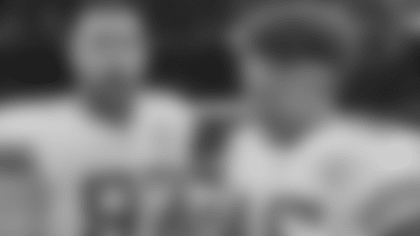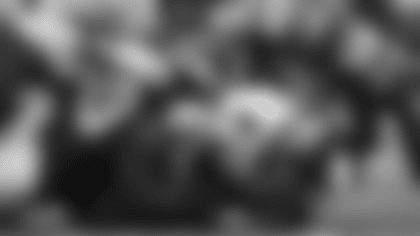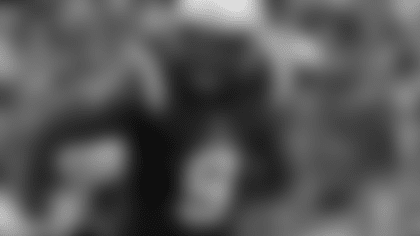The first game may not have gone as many fans expected (though if you read my preview of the Jaguars last week, you would have known that this team would be no slouch), there was a lot to learn from. The Eagles fought incredibly hard in all three phases of the game for the win, which is hard to come by in the NFL each and every week. Let's start with the offense ...
Since his arrival, head coach Chip Kelly has often talked about his desire to put opposing defenders in "dual conflict" and attack them. What does that mean exactly? That means you want to find defenders who have responsibilities in the run game and pass game, and make them choose which one to defend. It was definitely a theme on Sunday, and it resulted in what became the game-winning touchdown pass.
First, let's start off with a shot that should be familiar to repeat readers of this piece. This is a basic drawing of coverage responsibilities in Cover 3.

This is your basic look. You have three deep defenders (yellow) and four underneath defenders (blue). Of those four underneath defenders, you have the two on the outside, they are typically responsible for dropping outside the numbers as 'curl/flat' defenders. Then you have the two on the inside, they are responsible for dropping closer to the hash as "seam" or "hook" defenders. It was the onslaught against these curl/flat and hook defenders that resulted in a number of big plays for the Eagles.

While that's a look at the coverage responsibilities, here are the basic run responsibilities for those underneath defenders. Those two curl/flat defenders are your "force players" in the run defense. That means they are responsible for keeping the ball inside of them, forcing the ball to their help inside. The two hook players have responsibilities inside as well, though which gap (A gap, B gap, etc.) they are directly responsible for will change with different defensive calls. Both those are the basic responsibilities - curl defenders are your force players, while your hook defenders fit into the run defense inside.
It's no secret that the Jaguars and Gus Bradley want to play a lot of Cover 3, and the offense banked on it. Let's see how they put those underneath defenders in stressful situations where they had to choose to defend the run or the pass.

Before we see the whole play, let's fast-forward to the mesh point, where Nick Foles may hand the ball off to running back Darren Sproles or pull it and drop back to pass to any of four receivers running routes. Notice the two hook defenders, they have their eyes on the play-action, they have to be wary of the run before they can get to their landmarks in coverage.
Look at what happens to the hook defender, who is taken out of position thanks to the play fake from Foles. Zach Ertz runs a great route, widening the coverage and taking the curl defender further towards the sideline to give Foles even more room to hit him down the seam. This was great play design with great execution from the tight end and the quarterback. This wasn't an isolated case, however.
Here's another look at a shot from later in the game. Again, a hook defender is put in conflict. Jordan Matthews runs a crossing route behind him, is wide open and brings in the catch for a first down. Ertz, Matthews, Brent Celek and Jeremy Maclin were running across the middle or down the seam for a good amount of the afternoon. Were there some plays left on the field? Absolutely. But the execution will improve as the season wears on, and the fact is that the scheme worked very well on Sunday afternoon. Let's see how this resulted in Maclin's touchdown to take the lead for good.

The two players I want to focus on are rookie linebacker Telvin Smith and safety Chris Prosinski. Prosinski (right) is the single high safety in the deep middle of the field. His responsibility is to be as deep as the deepest receiver in the route combination. Smith is the hook player to the strong side of the field, responsible for dropping down the hash.
Look familiar? The play fake holds the attention of Smith, who is late getting back to his landmark. Prosinski sees Ertz running free down the seam, where the Eagles have hurt them time and time again all afternoon, and attempts to jump the route. He leaves his responsibility in the middle of the field, leaving nothing but green grass for Maclin to reel in the pass and run into the end zone untouched.

In case there was any doubt, look at the reaction from safety Winston Guy, who absolutely expected help in the middle of the field. The Eagles worked the seam all day, and when it mattered most they were able to take advantage of the Jaguars sneaking up to take it away with a deep pass over the top.
Defensively, the story was the third-down defense. The Jaguars were unable to convert on their first nine tries on third down, and ended the game just 2 of 14 (14.3 percent). How were they able to do it? Well, when it came to third-and-short, the Eagles just flat out owned the line of scrimmage.
Here's the first third down of the game. Look at Bennie Logan and DeMeco Ryans here. Logan gets under the pads of Jacksonville right guard Brandon Linder and drives him backwards. Ryans, meanwhile, fills in the backside and form tackles Gerhart beautifully. Textbook play from both guys.
Same exact play, but focus on two different guys. Look at Fletcher Cox here take on two blocks and hold his ground. Unbelievable strength and really set the tone for Cox here for the rest of the day. He was great from start to finish against Jacksonville. Trent Cole crashes down the line of scrimmage and is pushing blockers into the pile. This play was a great example of linemen up front doing their job and everyone getting to the ball carrier - great team defense.
Later in the game, and another third-and-short situation. Here we see Brandon Bair hold up two blocks and form a wall that the ball carrier is unable to force himself through, as Ryans fits in to clean him up and force fourth down.
The Eagles didn't just win third down at the point of attack. They won with great scheming up front taking advantage of some inexperience along the Jacksonville offensive line. Let's take a look at some examples of that in action.

Here, the Eagles have seven defenders at the line of scrimmage as possible players in the pressure scheme. Notice both inside linebackers, Ryans and Mychal Kendricks, located in the A gaps. The Eagles did this a lot last year, and the offensive front has to account for it schematically. They can not allow a free rusher at the quarterback up the middle. If there is a free rusher, he has to be the least dangerous man. In other words, he has to be coming off the edge.

Henne audibles and resets the protection. The running back and center will account for Ryans and Kendricks inside. Left tackle Luke Joeckel will account for Trent Cole off the edge. Nate Allen will be the free rusher. This is the best Jacksonville can do with a six-man protection scheme against seven potential rushers.
But the Eagles don't send seven rushers, they only send six. But Allen still comes free. Why? Because Cole bluffs his rush and steps back in coverage, Joeckel steps to him, and Allen comes clean off the edge to knock the ball out. The Eagles placed defenders in the A gaps throughout the game on third down with stifling results.
On this third-down call, the Jaguars decide to have the running back be responsible for linebacker Connor Barwin, not an ideal matchup you want to go with down after down, but when the A gaps are getting pressured this is the lesser of two evils. Barwin wins the matchup, gets his hands up and knocks down Chad Henne's pass to bring up fourth down.
Here, the Eagles show a slightly different look. The linebackers are inverted here, with Ryans and Kendricks on the edge and Barwin and Cole inside. "Will they come? Will they drop? Who will pick up who? It's third-and-long. It's a tight game." These are all thoughts going through Jacque McClendon's head. This was his first career start at center and he has to execute a shotgun snap with deafening crowd noise on top of it. It's a high snap, pressure is on its way, and Henne rushes a throw that falls incomplete.
There were more examples of A-gap pressure affecting Jacksonville on third down, but I think you get the idea. This is the last third-down stop I'll show, but for a different reason. I thought communication on the back end was good Sunday. Were there some lapses? Yes. But I thought there were some good examples of how far this defense has come as a unit. Remember some of the issues early last season due to bad communication on basic coverages? That appears to be a thing of the past. This group has been in this scheme for a full year, and it shows.

It's third-and-long, and the Jaguars are going to be running a "Switch" concept at the bottom of the screen. By crossing over each other, the Jaguars are hoping the two receivers' routes get the secondary confused, or at least causes interference, to allow one of their wideouts to break free in the open field.

The Eagles are in a type of Cover 2, with man coverage underneath. Malcolm Jenkins is the free player before the snap. He can help out where he is needed in coverage. Much like a play we saw last week in my review of the preseason, look at the pass-off here between Jenkins and cornerback Bradley Fletcher.
Jenkins picks up the in-breaking route. Fletcher passes him off to Jenkins and drops back to defend the vertical route down the sideline. Brandon Boykin sticks with his man through the route, in a trail position. Bradley Fletcher turns and makes his presence felt, as rookie Marqise Lee fails to attack the ball in the air and the ball falls incomplete. Great job of communication and execution in the back end for the Eagles' secondary.
Before wrapping this up, I wanted to take a quick look at the Eagles' special teams. Obviously, there were a number of great plays in the game. Rookie Cody Parkey was phenomenal in his first NFL game, booting five touchbacks and nailing a 51-yard field goal to tie the game in the fourth quarter. Donnie Jones dropped five punts inside the 20-yard line, one of which was perfectly covered by Boykin who dropped it in on the 1-yard line before falling into the end zone. You couldn't draw it up better on the white board. Bair blocked his second field goal of the year (the first came in the preseason). Darren Sproles was great in the return game and showed his game-breaking ability. But what about the core special teams guys? How impressive were they? Let's take a look.

Here's the kickoff that started the second half. Look at who is leading the charge down the field. At the top is linebacker Bryan Braman. The bottom circle is Chris Maragos. Both players were brought in this offseason to bolster the special teams units, and they both held up their end of the bargain against Jacksonville.
Follow Maragos on the play as he finds the ball like a heat-seeking missile, stays in his lane and brings the returner down inside the 20-yard line. The Eagles had multiple stops inside the 20 from the kickoff unit, as Earl Wolff was able to tack one up as well.
On the very first kickoff of the game, the Jaguars double-teamed Brandon Graham. Even with guys like Braman, Maragos and Brad Smith on the field, Graham was a guy they targeted and said he would be a player they wanted to keep in check. Graham did a good job fighting through and, as he does whenever he's on the field defensively, finished the play with great energy and helped celebrate the touchback, talking some trash along the way. Two kickoffs later, the Jaguars tried again to take Graham out early in the play. This time, he was ready.
Graham saw the early block coming, lowered his shoulder into the blocker and bowled his way right through. I love the way Graham is playing right now defensively, earning more reps at outside linebacker in this his second season in this defense, but you have to love the energy and attitude he is bringing to the special teams as well.
Let's get back to Maragos. He made two stops on special teams in Sunday's game, with the second coming in punt coverage.
Maragos is in the circle. Look at the head start that the man responsible for blocking him has. Maragos outruns him to his spot, getting over top of him (stacking him is the term) and putting him in a position to make the tackle. By getting over top of him, Maragos makes it so that the only way he can be blocked is if it's a block in the back (and therefore a penalty).
Let's flip it around and look at him on the punt return unit.
Here, Maragos completely takes his man out of the play. While the rest of his teammates are downfield covering, he has yet to even cross the line of scrimmage. By the time he is able to release, Maragos gets himself in position on his playside hip and blocks him through the whistle.
Look at the same play, but a different player.
That's rookie tight end Trey Burton, who initially gets beat on the release but works to get himself back in position. At first glance, one may say, "What did Burton do right there?" The answer is that he didn't commit the ultimate wrong. When Burton got beat, he didn't do the selfish thing that some young players do in that situation. He could've gotten a block in the back called against him. Instead, he smartly let Sproles make the man miss, threw his hands up to signal to the ref that "I didn't block him," and the play ensued. Smart play by the athletic and versatile rookie.
Last shot of the day - this is the same play from a different angle. Look at the job Jenkins and Nolan Carroll II do jamming the Jacksonville gunner, sending him to the sidelines after the snap. After the gunner works his way back into play, Jenkins sits on his hip and cleans him up.
The special teams unit played at a very high level on Sunday, something that was great to see considering the additions made to the roster in the offseason.
Fran Duffy is the producer of "Eagles Game Plan" which can be seen on 6abc Saturdays at 7:30 PM. Be sure to also check out the "Eagle Eye In The Sky" podcast each week online and on the Philadelphia Eagles podcast channel on iTunes. Prior to joining the Eagles in 2011, Duffy was the head video coordinator for the Temple University Football team under former head coach Al Golden. In that role, he spent thousands of hours shooting, logging and assisting with the breakdown of the All-22 film from the team's games, practices and opponents.























